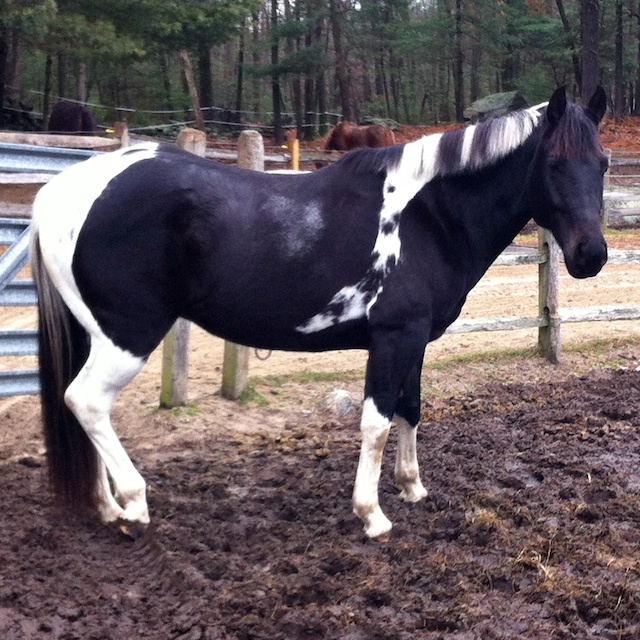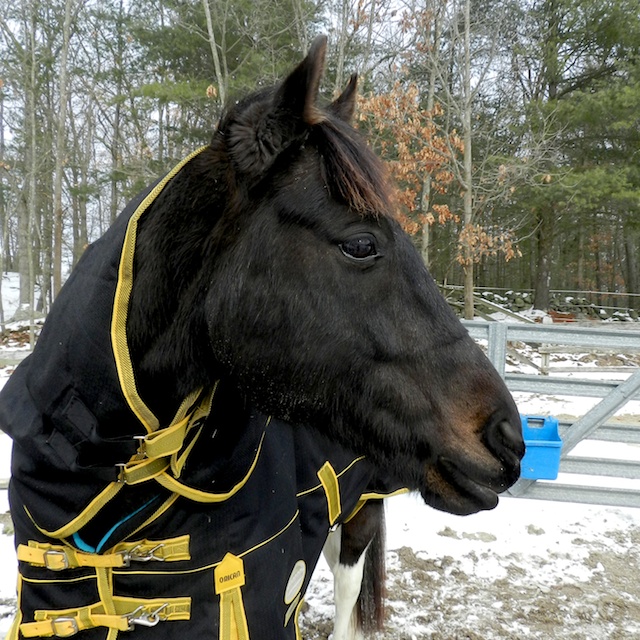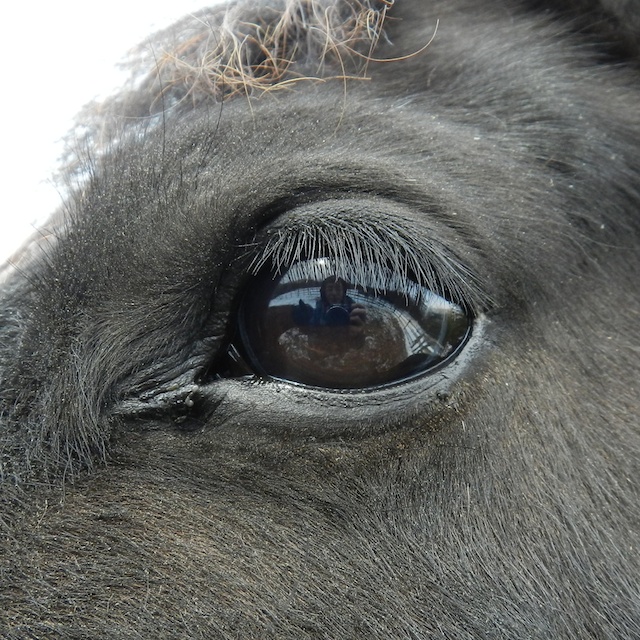The last thing that I was looking for when I went shopping for a horse was a flashy paint. In fact, my preference would have been for a solid brown or a bay with black points. Understated and classic. I certainly didn’t go out looking for a horse that inspired Oh! He is so beautiful! bursts of admiration. However, that is what I got. Even standing in mud, Tonka looks good.
What I did go looking for, my #1 criterion, was what horsemen call a kind eye. (Although, of course, horses have two eyes, it is always referred to in the singular.) Tonka has one.
Like people, horses are born with their own unique personalities. Some are introverts and some are extroverts. Some horses are competitive and have the look of eagles. Some are worriers, and some are endless, mischievous troublemakers. Some have gentle souls and thoughtful minds, and those are the horses with kind eyes.
You can’t train a horse to have a kind eye, but you can crush it. There are obvious ways to do that, such as physical abuse. There are other ways to do it as well, that are more subtle but far more prevalent.
Just like the well-behaved child in school is often ignored, so too, a good horse is often casually handled. Only when he acts up (perhaps a spook on the lead-line) is he paid attention to, and then it is with a yank on the rope. The horse with the kind eye who is ignored might learn to misbehave for attention. Or, more likely, he will simply go dull. That kind eye will turn listless.
Horses respond to pressure, both physically by touch and also when others enter into their personal space. They are exquisitely tuned to body language. They are herd animals that can read the emotional life of another horse 20 feet away by the flick of an ear. They are animals that form lifelong friendships. They also hold grudges. Horses believe that everything has cause and effect. So to keep that kind eye intact, it is not enough to simply dote on your horse. it’s not the love you feel, or the treats you give, but how you treat him. Every action (or inaction) matters.So, to nurture Tonka’s kind eye, I have to comport myself in a way that relates to him (even across a field, my movement affects his) and I also have to behave consistently and with purpose.
People like to spoil their horses, and it is easy to do. Horses have big appetites and they relish treats. You might say that you want to give your horse a carrot just because you love him, but the horse doesn’t see it that way. In his mind, there must be a reason why you have handed over that bit of food. If he nuzzles you and gets a carrot, the next time he sees you he’ll try another nuzzle. That doesn’t work? He’ll shove. I don’t want a pushy, needy horse, but that doesn’t mean that I never give Tonka carrots. Instead, they are offered only after I ask him to do something and he does it. I might ask for a “touch” or a “head down” or a “walk next to me.” I ask, he responds. I pay attention to him as much as he does to me. He knows the reward is coming because of a clear sound marker (I use a clicker). He knows what to expect, and he knows that what he does matters to me. Horses crave this sort of interaction. Tonka enjoys these short work and treat training sessions. He even adds his own twists to it to see if I really am paying attention. We’ve been doing off-lead work. during which I ask him to walk next to me, his head pointing straight ahead, parallel to my shoulder. Lately, while I walk, he’s been all contained, exuberant energy. He trots. He gets a few steps ahead and looks back. No click. He slows, he backs up, he jigs next to my shoulder. He’s asking a question, “what gets the reward, just being next to you, or do I have to walk, too?” I tell him, through body language, and then a click, that as long as he stays at my shoulder, that he can use whatever gait he wants. I might regret this later, but it sure is cute. Tonka’s kind eye glimmers with intelligence and trust.
His fancy black and white coat is a bonus. I confess that I do like having such a handsome horse! But in the end, it’s the relationship that matters.




I got my own reminder this week. When I approach my horse all business-like to groom and tack him up (easy to do because of my personality and limited time), he gets cranky. If I slow down, acknowledge him and interact with him more, the crankiness goes away. I may have less time to ride that way, but doing so gives me a partner, not just a project.
Good for you to recognize that! Anyway, we ride too long. It’s a fallacy that horses learn by repetition. They learn best in short, frequent increments. I bet you’ll get better results in half the time :) Getting them physically fit and athletic is another story. But- that’s the excuse to go out on the trails and hills.
I like the reflection of you with your camera in his eyeball. It’s a treat to learn about horses from you.
PS Old Farmer’s Almanac has posted that tomorrow is National Pie Day. They are calling your name!
Unusual selfie! And very enjoyable reading your posts, horses, hens, and bunny. And dogs, of course. I see one of the girls is cuddled up next to Phoebe. It’s cold!
Your comment about some horses being “endless, mischievous troublemakers” reminded me of a horse belonging to a former landlord of mine in Connecticut. This horse could outwit any stall closure or muzzle put on him and get out. But…he was not satisfied with getting just himself out…he let out the other horses in the barn as well. I’ll never forget pulling up the driveway one evening after a long, hard day at the office to see several horses running thru the backyard. All the stress of the day flew away at the sight.
I had a chestnut thoroughbred mare that we joked was a “reincarnated silent movie star.” If the barn manager wasn’t on time, my mare would unlatch her stall AND her boyfriend’s next door, go out to the pasture, and holler to have that gate opened for her. So, I know you’re not exaggerating!
Can I offer a suggestion? If you want more control over this so that he knows when he “has” to behave, I have a way to do that. You will want to adapt it to your situation, mine was in form with the rules where I worked.
In most places I worked it was “required” to put the chain over or under the nose when handling the horse. But I knew from the first place I worked that most “problem” horses just needed a few extra minutes a day. Easiest for me was to take them out for a “walk around” with no purpose but to go places they wouldn’t normally get to visit. So I would put the chain through a hole in the halter and hook it back on itself. If they ignored the command to go easy or hold up or if they started trying to drag me, I would cut them off and the chain would go back on. We would then practice some lead line etiquette. The chain would come off and we would resume our walk. A second offense saw them right back to their stalls. Two or three outings was all it took for them to figure out the rules. Just the simple act of turning the chain back on itself would get the horses at a couple of places I worked at excited and jumping in place in the barn. It made me sad that for them a simple 15-20 minute walk was the highlight of their day. *shakes head* But anyway, the point is, it is just that simple to let them know when they can goof off with you and when they need to behave. No regrets needed on down the line!
I probably should add I got yelled at from time to time for doing this. But as I pointed out – since everyone else always used the chain the odds of someone doing what I did were pretty damn slim. So the horses were still “safe” for everyone else!
Hi Robin, we’re coming at training from two totally different places. I do agree with you that taking a horse for walks is a good thing. I do that almost daily with Tonka. However, I don’t want any more “control.” I have plenty. Tonka already has perfect manners when led with a cotton lead rope. I am training him to walk by my side WITHOUT a lead rope. If I need a chain to contain him, then I am working from the wrong place, to the wrong place. The point here is that I am training Tonka to think about where he wants to be in relationship to me. He has a choice – there’s nothing physically holding him – and he chooses to be by my side. This is all without punishment. We are working towards precision. I look for what he’s doing right, and I reward that, and then ask for the next increment. At no time is he dangerous, pulling me, or need to be punished. I do not have to correct behavior. I could easily train him to walk slowly next to me, without ever using a rope or a chain. Nor do I need to give him a timeout in a stall. I communicate clearly and precisely and positively with the clicker. The trotting next to me is contained, polite, and rather adorable. I have no use for a chain. At all.
Actually we’re not really coming from totally different places. I do understand what you’re doing. I guess it just didn’t come out right. You expressed a possibility of regretting allowing him to play around. A legitimate concern with a large animal. I was simply trying to show how easy it was for the horse to learn the difference between fun times and no nonsense times (despite the methods). I was -not- advocating that you start yanking Tonka around. My brain couldn’t even wrap itself around you smacking your animals around. Please reread my first paragraph. The way you treat your animals is why I like coming here. You care.
In a perfect life all horses would be raised and handled like Tonka. Chains aren’t my first choice, but that’s the way it was. When you work horses for a living and the people you work for have “their” own way of doing things, you do it or you don’t have a job. I was considered a “feel good” person back then because I was always trying to make things better for the animals. Which wasn’t a priority for a lot of people. Money was. I was always the one having to fix the problems, though, which meant there wasn’t a lot of time for the fun stuff. (Or as I used to put it, “Cleaning up other peoples’ messes.”) They liked what I did but didn’t want to change what they were doing that caused the problem. You can’t imagine how depressing it is to get a horse back to trusting and working for people only to have the horse taken and given back to the same person who screwed him up to begin with. And then they hand you another one. It got old and I got burned out. A lot of things have changed in the past 30 years, but there is still a ways to go.
Again, I really was -not- suggesting you go after Tonka with a chain.
Robin, I know that you weren’t suggesting that I go after Tonka with a chain, and I know that you have the good of all animals at heart. I also understand about being frustrated with other trainers. When I was 16, my trainer whipped a horse, and I never talked to him again, despite working in the same barn. However, I still believe that we come at training from two different directions. The basis of what I do is to watch for good behavior, and reward it. The other way is to wait for bad behavior and correct it. I’m not saying this to argue with you, but to explain to other readers that there truly is a difference in approach. I’ll be writing a lot more about this in the months to come.
Tonka seems to have very good conformation. Can’t wait to see how he is this year with you working with him, bet he’ll be great!
Thank you! He’s got perfect front legs with strong, short cannons. Perfect angle to his nicely-formed feet. A good head, although his lower jaw juts out a tad. Nice width to his chest and good quarters. His withers are a tad prominent and his back dips a bit. The overall picture is balanced. I’m pleased :) He’s quite green in the ring, basic walk, trot canter, so we have a lot of work to do, which I’m looking forward to.
From the first picture, his neck seemed a bit short and thick, and I see what you mean with his withers and back. I can’t wait to see how much he improves! I’m so happy that you have a horse, it’s so wonderful to see a post about Tonka. :)
Actually, he has a nice neck – it’s the photo. This is why there are professional horse photographers. Get the angle wrong, and the horse looks out of proportion! :)
Is this the first time you’ve posted a picture of his art side? He is beautiful all over and a loving companion, I’m sure.
I love that. His “art” side :)
Terry, I don’t know for cannons or withers, but I love his color. The white & black mane and the swoosh down his side make for a very handsome horse! You two make a good looking “couple” and will stop traffic.
It’s very unusual to have a white mane against a black neck. I love his coloring, too.
It is all in the eye of the beholder….great photograph…..great relationship!
It’s a relationship in progress, but I do enjoy the process.
I can see why his breed is so often featured in Native American horse art. I don’t if you ever seen the Trail of Ponies type art, but some of those fit Tonka a to a tee. I know nothing about horses but one thing I don’t understand that horses apparently see the way we walk as predatory ? How is it because we are more upright or is it another type movement ?
His color is found in horses in Europe, too. In England he’d be called piebald. In America, though, there is a body type and specific breed. As far as people being predatory… I don’t buy that, except for the fact that all of their senses are tuned into the fact that they are prey for large predators. They see and react to movement and stealth, and have very good eyesight for things far away and to the sides.
Yep..I ALWAYS looked at the eyes when purchasing a horse. We called it a “squishy” eye. When I ride with others I notice their horse’s eye…I stay away from the horse with “the wild eye”…I have seen plenty of those. Tonka for sure has a “squishy” eye!
What a beautiful boy he is and what a lovely relationship you are building. It is a joy to share with you.